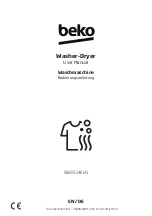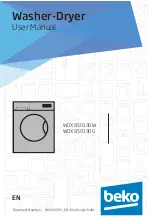
BEFORE CALLING FOR SERVICE
(cont.)
Problem
Possible Causes
Solutions
Clothes take too
long to dry
• Load is not properly sorted.
• Large load of heavy fabrics.
• Dryer controls are not set
properly.
• Lint filter needs to be
cleaned.
• Exhaust ducts blocked, dirty,
or duct run is too long.
• House fuse is blown, circuit
breaker has tripped, or
power outage has occurred.
• Dryer is overloaded.
• Dryer is underloaded.
• Separate heavy items from lightweight items. Larger
and heavier items take longer to dry.
• Heavy fabrics take longer to dry because they tend
to retain more moisture. To help reduce and maintain
more consistent drying times for large and heavy
fabrics, separate these items into smaller loads of
a consistent size.
• Use the appropriate control settings for the type of
load you are drying.
• Make sure the lint filter is cleaned before every load.
With some loads that produce high amounts of lint, it
may be necessary to clean the filter during the cycle.
• Confirm that the exhaust ductwork is properly
configured and free of debris, lint, and obstructions.
Make sure that outside wall dampers can open
properly and are not blocked, jammed, or damaged.
• Reset circuit breaker or replace fuse. Do not
increase fuse capacity. If the problem is a circuit
overload, have it corrected by a qualified electrician.
• Divide larger loads into smaller loads for drying.
• If you are drying a very small load, add a few extra
items to ensure proper tumbling action.
Clothes are wrinkled
• Clothes dried too long
(overdried).
• Clothes left in dryer too long
after cycle ends.
• Overdrying a load of laundry can lead to wrinkled
clothes. Try a shorter drying time, and remove items
while they still retain a slight amount of moisture.
• Remove items from the dryer immediately at the
end of the cycle. Use the WRINKLE CARE option to
continue tumbling clothes at the end of the cycle, for
up to 3 hours.
Clothes are shrinking
• Garment care instructions
are not being followed.
• To avoid shrinkage, please carefully follow the fabric
care instructions for your garment, because some
fabrics will naturally shrink when washed. Other
fabrics can be washed but will shrink when dried
in a dryer. Use a low or no heat setting and/or the
RACK DRY option.
Problem
Possible Causes
Solutions
Dryer does not heat
• House fuse is blown, circuit
breaker has tripped, or
power outage has occurred.
• Gas supply or service turned
off (gas models only).
• Reset circuit breaker or replace fuse. Do not
increase fuse capacity. If the problem is a circuit
overload, have it corrected by a qualified electrician.
• Confirm that the house gas shutoff and the dryer
gas shutoff are both fully open.
BEFORE CALLING FOR SERVICE
Your dryer is equipped with an automatic error-monitoring system to detect and diagnose problems at an
early stage. If your dryer does not function properly or does not function at all, check the following before
you call for service.
Dryer will not
turn on
• Power cord is not properly
plugged in.
• House fuse is blown, circuit
breaker has tripped, or
power outage has occurred.
• Make sure that the plug is plugged securely into a
grounded outlet matching the dryer’s rating plate.
• Reset circuit breaker or replace fuse. Do not increase
fuse capacity. If the problem is a circuit overload,
have it corrected by a qualified electrician.
Greasy or dirty spots
on clothes
• Fabric softener used
incorrectly.
• Clean and dirty clothes being
dried together.
• Clean and dirty clothes being
dried together.
• Confirm and follow the instructions provided with
your fabric softener.
• Make sure to use your dryer to dry only clean
items, because dirty items can soil clean clothes
placed in the same or subsequent loads.
• Stains on dried clothes are actually stains that
weren’t removed during the washing process.
Make sure that clothes are being completely
cleaned according to the instructions for your
washer and detergent.
Display shows error
code tE1 or tE2
• Thermistor is malfunctioning.
• Turn off the dryer and call for service.
Lint on clothes
• Lint filter not cleaned
properly.
• Laundry not sorted properly.
• Excess static in clothes.
• Dryer is overloaded.
• Tissue, paper, etc., left
in pockets.
• Make sure the lint filter is cleaned before every
load. With some loads that produce high amounts
of lint, it may be necessary to clean the filter
during the cycle.
• Some fabrics are lint producers (i.e., a fuzzy white
cotton towel) and should be dried separately from
clothes that are lint trappers (i.e., a pair of black
linen pants).
• See the
Excess static in clothes after drying
section below.
• Divide larger loads into smaller loads for drying.
• Check pockets thoroughly before washing and
drying clothes.
Excess static in
clothes after drying
• Fabric softener not used or
used incorrectly.
• Clothes dried too long
(overdried).
• Drying synthetics, permanent
press, or synthetic blends.
• Use a fabric softener to reduce static electricity.
Be sure to follow the manufacturer’s instructions.
• Overdrying a load of laundry can cause a buildup
of static electricity. Adjust settings and use a
shorter drying time, or use SENSOR DRY cycles.
• These materials can cause static buildup. Try
using a fabric softener.
Drying time is not
consistent
• Heat settings, load size, or
dampness of clothing is not
consistent.
• The drying time for a load will vary depending on the
heat setting, the type of heat used (electric, natural,
or LP gas), the size of the load, the type of fabrics,
the wetness of the clothes, and the condition of the
exhaust ducts and lint filter.
CHECK FILTER light
is on during the
drying cycle
• Lint filter is almost clogged
or full.
• Pause the drying cycle and clean the lint filter.
2 bars are displayed
inFLOWSENSE
indicator
• Ductwork is slightly too long
or has too many turns/
restrictions.
• Partial blockage of the
ductwork due to lint buildup.
• Install a shorter or straighter duct run. See the
Installation Instructions.
• Ductwork should be checked/cleaned soon.
Dryer can be used in this condition, but drying
times may be longer.
4 bars are displayed
inFLOWSENSE
indicator
• Ductwork is too long or has
too many turns/restrictions.
• Significant blockage of the
ductwork due to lint buildup
or debris.
• Install a shorter or straighter duct run. See the
Installation Instructions.
• Ductwork should be checked/cleaned immediately
to remove lint build up and other blockages. Dryer
can be used, but performance and efficiency will be
greatly reduced.
35
Содержание DLE2301R
Страница 43: ...43 ...
Страница 120: ...LG ELECTRONICS INC GARANTIE LIMITÉE APPLICABLE AUX SÉCHEUSES LG CANADA 1 an 1 an 1 an 1 an 120 ...
Страница 121: ......
Страница 122: ......
Страница 123: ......
Страница 124: ...P No 3828EL3003Y ...
















































